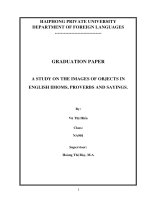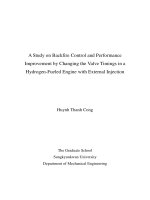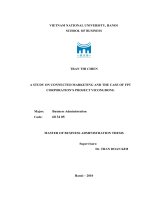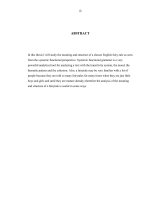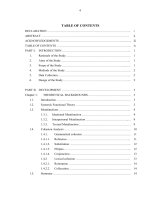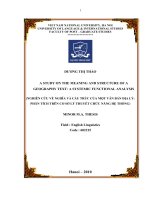A STUDY ON THE DURABILITY AND PERFORMANCE OF PHOTOVOLTAIC MODULES IN THE TROPICS
Bạn đang xem bản rút gọn của tài liệu. Xem và tải ngay bản đầy đủ của tài liệu tại đây (4.73 MB, 119 trang )
A STUDY ON THE DURABILITY AND
PERFORMANCE OF PHOTOVOLTAIC MODULES
IN THE TROPICS
XIONG ZHENGPENG
NATIONAL UNIVERSITY OF SINGAPORE
2015
A STUDY ON THE DURABILITY AND
PERFORMANCE OF PHOTOVOLTAIC MODULES
IN THE TROPICS
XIONG ZHENGPENG
M.Eng., National University of Singapore
B.Eng., Huazhong University of Science & Technology
A THESIS SUBMITTED
FOR THE DEGREE OF DOCTOR OF PHILOSOPHY
DEPARTMENT OF MECHANICAL ENGINEERING
NATIONAL UNIVERSITY OF SINGAPORE
2015
vi
DECLARATION
DECLARATION
I hereby declare that this thesis is my original work and it has been written by
me in its entirety. I have duly acknowledged all the sources of information
which have been used in the thesis.
This thesis has also not been submitted for any degree in any university
previously.
___________________
XIONG ZHENGPENG
Jun 26, 2015
vii
ACKNOWLEDGEMENTS
I would like to thank my supervisor Professor Andrew A.O. Tay,
co-supervisor Professor Armin G. Aberle, and scientific advisor Dr. Timothy
M. Walsh for their guidance in my PhD study. Their support greatly helped
me in exploring durability, characteristics, and simulations of PV modules. It
was my great pleasure to work with them in this work.
Also, I would like to thank my lab fellows of the PV Module Performance
Analysis Unit of the Solar Energy Research Institute of Singapore for their
support on performing various tests. Without them it would have been
impossible to finish the test tasks for the study.
Thanks to my colleagues in the Solar Energy Research Institute of Singapore
and the Department of Mechanical Engineering for their help and discussions.
And to my family, Yanqiong, Yuyang, and Yicheng, thank you for supporting
me in the journey.
viii
TABLE OF CONTENTS
DECLARATION PAGE i
ACKNOWLEDGMENTS ii
TABLE OF CONTENTS iii
SUMMARY vi
LIST OF TABLES ix
LIST OF FIGURES x
ABBREVIATIONS xiv
CHAPTER 1 – INTRODUCTION 1
1.1 Solar photovoltaics 1
1.2 Terrestrial PV modules 4
1.3 Durability of PV modules 7
1.4 Conclusions 8
CHAPTER 2 - PV MODULE DEGRADATION MECHANISMS 9
2.1 Literature Survey 9
2.2 Accelerated stress tests for PV modules 16
2.3 Objective of PV module testing in this study 18
2.4 Conclusions 19
CHAPTER 3 - SIMULATIONS OF MOISTURE DIFFUSIONS 20
3.1 Literature Survey 20
3.2 Material properties in FEA simulation 22
3.3 Moisture diffusion simulation: Theory verification 23
3.4 Moisture diffusion simulation: Effect of testing conditions 25
3.5 Moisture diffusion simulation: Effect of backsheet thickness 34
3.6 Moisture diffusion simulation: Effect of encapsulant material 36
3.7 Moisture diffusion simulation: Effect of module structure 38
ix
3.8 Conclusions 40
CHAPTER 4 - PV MODULE STRESSING TESTS 43
4.1 Ten types of commercial PV modules in the stud y 43
4.2 Test plan and PV module performance assessment 49
4.3 Standard stress tests (Humidity Freeze, Thermal Cycling, Damp Heat) 51
4.4 Tightened stress test (Damp Heat 90/90) 53
4.5 Tightened stress test (Damp Heat 85/85 with 1000V DC bias) 55
4.6 Tightened stress test (UV exposure 50KWh/m
2
) 63
4.7 Study of instability of thin-film modules 65
4.8 Analysis of IV curve parameters and power degradation 68
4.9 Conclusions 71
CHAPTER 5 - PV MODULE CHARACTERIZATION TESTS 73
5.1 Nominal Operating Cell Temperature @ Singapore (NOCT
sg
) 73
5.2 Temperature Coefficient 77
5.3 Performance at NOCT
sg
78
5.4 Outdoor exposure test 79
5.5 Low-irradiance performance 81
5.6 Hot-spot test 82
5.7 Conclusions 84
CHAPTER 6 - SUMMARY AND PREDICTION OF PV MODULE
PERFORMANCE 85
6.1 Summary of PV module performance 85
6.2 Prediction of PV module performance 87
CHAPTER 7 – CONCLUSIONS AND FUTURE WORKS 92
7.1 Conclusions 92
7.2 Future works 96
REFERENCES 98
x
SUMMARY
Photovoltaic module degradation causes significant impact on PV system
lifetime. The degradation is demonstrated to be caused by various factors such
as photo-degradation by UV photons in sunlight, corrosion by moisture
ingress, thermal degradation in field service, and thermo-mechanical stress due
to thermal cycling, wind/snow/hail, etc. This thesis describes a study on the
durability of different types of PV modules for terrestrial applications.
In the study, stressing and characterization tests were conducted on 10 types of
commercially available thin-film PV modules (Amorphous silicon, micro-
morph silicon, amorphous silicon tandem, CdTe, and CIGS) and silicon-wafer
based PV modules (Monocrystalline silicon, multicrystalline silicon,
monocrystalline silicon BIPV, Back-contact monocrystalline silicon, and
Hetero-junction monocrystalline silicon with amorphous silicon thin layer).
The PV modules were tested with different stressing conditions (moisture,
UV, thermal, mechanical, electrical, outdoor, etc.). Several tightened stress
test conditions, e.g. Damp heat 90C/90%R.H., Damp Heat 85C/85%R.H.
with 1000 V DC bias, etc, further differentiated degradation rates of the
modules. Moisture ingress simulations were performed with Finite Element
Analysis (FEA) software ABAQUS-CAE
®
to reveal moisture concentration
distributions under different test conditions and different materials/structure.
Other PV module characteristics (e.g. temperature coefficient, nominal
operating cell temperature, low irradiance performance, etc) for different PV
module technologies were also obtained in order to predict electricity
generation in Singapore’s outdoor conditions. Outdoor performance results of
xi
the modules for eight months were summarized in order to correlate the results
from accelerated stressing tests with actual performance under Singapore
weather conditions.
Degradation rates of each PV module technology were obtained in thermo-
mechanical stressing, moisture induced corrosion, UV induced degradation,
etc to reveal the acceleration factors in order to better predict lifetime of PV
modules. From the different behaviours of the modules, certain solutions were
derived to reduce the effects of such stressing on PV module performance. The
interactions of IV curve parameters with module power were analysed. The
open-circuit voltage V
oc
was found as the most important factor that resulted in
power degradation from the stressing tests.
FEA simulations demonstrated the effect of moisture dose in accelerated damp
heat and outdoor test, which revealed uneven distribution of moisture
concentration in silicon wafer PV modules. Other explorations were conducted
on structures and materials of PV module for design improvement against
moisture ingress.
Various characteristic tests were performed to obtain performance parameters
(NOCT
sg
, temperature coefficient, performance at NOCT
sg
) for better
estimation of PV module’s performance in Singapore outdoor test condition.
The instability issue of thin-film modules, particularly for amorphous silicon-
based modules, were studied through light soaking and thermal annealing
which revealed strong thermal annealing effects for a-Si based modules at as
low as 65C and 85C.
xii
A module power prediction was developed by including the effects from
degradation and characteristics of PV modules. The predicted power output
was compared with outdoor test results in Singapore for each type of module.
The CdTe module selected in this study seems to be a good choice in terms of
module energy yield for Singapore weather.
xiii
LIST OF TABLES
Table 1. Common cathodic and anodic reactions of galvanic corrosion
Table 2. Geometry and materials of the FEA model for moisture simulation
Table 3. Boundary condition, initial condition and temperature loading of FEA model
Table 4. Ten types of commercially available PV modules under tests
Table 5. Test sequences of accelerated stress tests
Table 6. Visual defects after 1000 V 85°C/85%R.H. Damp Heat for 650 hours in
positive bias (PB) and negative bias (NB) modes
Table 7. Temperature coefficient of ten PV modules measured in the PVPA Unit of
SERIS
Table 8. Degradation rate (%/hr) measured for different PV technology by stress tests
and outdoor exposure test
xiv
LIST OF FIGURES
Fig. 1. NASA’s “Helios” solar plane (Upper); Singapore’s “solar park” (Lower).
Fig. 2. NREL’s efficiency map of the best research solar cell in the world.
Fig. 3. Common structures of PV modules and solar cells.
Fig. 4. Sketch of Potential-Induced Degradation (PID), showing ion moving paths
when bias voltage is applied between active circuit and module frame.
Fig. 5. Temperature dependent material properties of common PV packaging
materials.
Fig. 6. Moisture distribution in a film. Moisture ingress from two sides of a totally
dried film. (Upper) Analytical solution vs. (Lower) FEA result. FEA result matches
with that of the analytical solution.
Fig. 7. Two-dimensional model for moisture diffusion in a Glass-Backsheet Si-wafer
PV module. Symmetric planes are located at the centre of solar cell and the centre of
the cell-to-cell gap.
Fig. 8. Temperature of a Si wafer PV module and relative humidity of air measured in
a typical sunny day in Singapore.
Fig. 9. Normalized moisture concentration in backsheet and encapsulant layers of a
Si wafer PV module at 2 hours, 18 hours and 1000 hours in 85C/85%R.H.
Fig. 10. Normalized moisture concentration C/Csat along the bottom of the Si wafer
at various times during the Damp Heat 85C/85%R.H. test.
Fig. 11. Normalized moisture concentration C/Csat along the top of the Si wafer at
various times during the Damp Heat 85C/85%R.H. test.
Fig. 12. Moisture concentration at various locations on the Si wafer interfaces in
Damp Heat and Outdoor tests in Singapore.
Fig. 13. Cumulative moisture amount (moisture dose) at Si wafer surfaces after
85°C/85%R.H. and Outdoor test of Singapore for 1000hours.
Fig. 14. Moisture concentration and normalized moisture concentration at the centre
of bottom surface of Si wafer in Outdoor test simulation.
Fig. 15. FEA simulation of normalized moisture distribution in encapsulant layer after
Damp Heat 85C/85%R.H. 1000hrs. Encapsulant: EVA (Upper) and ionomer
(Lower).
xv
Fig. 16. Contour plot of mass flow rate in encapsulant layers of a Glass-Glass Si
wafer PV module at a 30 mm region from the edge of the module after Damp Heat
85C/85%R.H. for 1000 hours. The string on Si wafer exhibits a blocking effect in
retarding moisture diffusion towards wafer centre region.
Fig. 17. Normalized moisture concentration C/Csat at the centre of top surface of the
Si wafer near the edge of a Glass-Glass Si wafer PV module in Damp Heat test. The
Si wafer is located along the horizontal centre line of the module.
Fig. 18. Photos of a-Si PV module. Size: 990 x 960 x 40 mm. Glass-Backsheet
structure with frame and thick edge sealing rubber.
Fig. 19. Photos of CdTe PV module. Size: 1200 x 600 x 6.8 mm. Glass-Glass
structure without frame but with edge sealant.
Fig. 20. Photos of a-Si/a-Si tandem PV module. Size: 1308 x 1108 x 50 mm. Glass-
Backsheet structure with frame and edge sealing tape.
Fig. 21. Photos of micromorph PV module. Size: 1129 x 934 x 46 mm. Glass-
Backsheet structure with frame and edge sealing tape.
Fig. 22. Photos of CIGS PV module. Size: 1235 x 641 x 35 mm. Glass-Glass
structure with frame and edge sealant.
Fig. 23. Photos of mono-Si/a-Si heterojunction PV module. Size: 1580 x 812 x 35
mm. Glass-Backsheet structure with frame and edge sealing adhesive.
Fig. 24. Photos of multi-Si PV module. Size: 1650 x 992 x 46 mm. Glass-Backsheet
structure with frame and edge sealing adhesive.
Fig. 25. Photos of back-contact mono-Si PV module. Size: 1037 x 527 x 46 mm.
Glass-Backsheet structure with frame and edge sealing adhesive.
Fig. 26. Photos of mono-Si PV module. Size: 1581 x 809 x 40 mm. Glass-Backsheet
structure with frame and edge sealing adhesive.
Fig. 27. Photos of mono-Si BIPV module. Size: 1795 x 950 x 12 mm. Glass-Glass
structure without frame. Wafers are sparsely located to allow light to pass through
the gaps between wafers.
Fig. 28. An IV curve measured for a micromorph PV module by the flashing test
system in the PVPA of SERIS.
Fig. 29. Delamination and blisters at edge-sealant region of CdTe module after Damp
Heat 85/85 test (Viewing from the back of the module). Left photo (amplified).
Fig. 30. Module efficiency after standard stress test series (Thermal Cycling 200
cycles, Humidity Freeze 10 cycles, and Damp Heat 85/85 1000 hours) normalized by
their efficiency prior to the stressing.
xvi
Fig. 31. Module efficiency after Damp Heat tests 85/85 and 90/90, normalized by
their efficiency prior to the stressing.
Fig. 32. Module efficiency after bias Damp Heat tests normalized by their efficiency
prior to the stressing.
Fig. 33. “Hair-like” delamination at thin-film layer under the front glass of CdTe
module after the negative bias Damp Heat 85/85 test.
Fig. 34. “Hair-like” delamination along the edge frame of micromorph PV module
after the negative bias Damp Heat 85/85 test. The delamination is located at the thin-
film layer under the front glass.
Fig. 35. “Dot-like” delamination at thin-film layer under the front glass of a-Si/a-Si
tandem module after the positive-bias Damp Heat 85/85 test; Frame corrosion is also
shown.
Fig. 36. Glass surface deterioration of mono-Si back-contact module after the positive
bias Damp Heat 85/85 test. White “mist” on front glass and frame corrosion are also
shown.
Fig. 37. Discoloration of silver metallization on the solar cell of mono-Si module after
the positive bias Damp Heat 85/85 test.
Fig. 38. CdTe PV module shows yellowish colour at the edge sealant region (viewed
from the back of the modules) post the UV test. The yellowish colour becomes more
obvious with extended UV test duration.
Fig. 39. Module power variation after UV 15 kWh/m
2
and UV 50 kWh/m
2
tests.
Fig. 40. Module efficiency at different test points of light-soaking test, normalized by
their initial efficiency.
Fig. 41. Module power variation after thermal annealing. A higher annealing
temperature generally leads to an increase in power for a-Si based modules.
Fig. 42. Module power variation after stress tests to show the effect of thermal
annealing on a-Si based modules. The duration above 50°C are shown for these tests.
Longer heating times generally lead to more power gain due to thermal annealing
effect.
Fig. 43. Interaction graph of V
oc
and MPP variations after stress tests.
Fig. 44. Interaction graph of I
sc
and MPP variations after stress tests.
Fig. 45. Interaction graph of FF and MPP variations after stress tests.
Fig. 46. Interaction graph of R
s
and MPP variations after stress tests.
xvii
Fig. 47. Interaction graph of R
sh
and MPP variations after stress tests.
Fig. 48. NOCT
sg
test for an amorphous-Si tandem PV module and a heterojunction
mono-Si/a-Si module in Singapore.
Fig. 49. A daily measurement of NOCT
sg
for two PV modules in the study. Apparent
differences of module temperature attributed to module structure, materials, etc.
Fig. 50. Temperature monitoring in NOCT
sg
test of a mono-Si back-contact PV
module in Glass-Backsheet structure. Top surface was found ~3°C (max.) cooler than
bottom surface of the module.
Fig. 51. Temperature monitoring in NOCT
sg
test of a CIGS PV module in Glass-Glass
structure. Top surface was found ~10°C (max.) cooler than bottom surface.
Fig. 52. NOCT
sg
temperature measured in Singapore for ten types of PV modules.
Fig. 53. IV curves measured at different temperatures for a-Si and mono-Si PV
modules.
Fig. 54. Temperature coefficient, NOCT
sg
and normalized module power at NOCT
sg
.
Fig. 55. Module power variation after preconditioning and outdoor exposure tests.
Fig. 56. Low-irradiance test at 200 W/m
2
irradiance
and module temperature 25C.
Fig. 57. Hot spots detected at the back of micromorph tandem PV module by an IR
camera in hot-spot test.
Fig. 58. Module power variation influenced by hot-spots for four thin-film PV
modules and a Si-wafer PV module.
Fig. 59. Calculated, predicted and measured energy yield of ten types of commercial
PV modules. Outdoor measurements were done between September 2010 and April
2011 on a rooftop at the National University of Singapore.
Fig. 60. Degradation rate of PV modules after stress tests and outdoor exposure test,
compared with the target rate (-0.0001%/hr) of 25 years of service.
xviii
ABBREVIATIONS
A-Si Amorphous Silicon
BAPV Building-Attached Photovoltaics
BIPV Building-Integrated Photovoltaics
BSF Back Surface Field
CdTe Cadmium Telluride
CIGS Copper Indium Gallium Selenide
CSF Comprehensive Stress Factors
CTE Coefficients of Thermal Expansion
CVD Chemical Vapour Deposition
DC Direct Current
DH Damp Heat
EVA Ethylene-Vinyl-Acetate
FEA Finite Element Analysis
FF Fill Factor
HF Humidity Freeze
IEC International Electrotechnical Commission
JPL Jet Propulsion Laboratory
LID Light-Induced Degradation
Mono-Si Monocrystalline Silicon
MPP Maximum Power Point
MPPT Maximum Power Point Tracking
Multi-Si Multicrystalline Silicon
NASA National Aeronautics and Space Administration
NB Negative Bias
NOCT Nominal Operating Cell Temperature
NREL National Renewable Energy Laboratory
xix
PB Positive Bias
PET Poly-Ethylene-Terephthalate
PID Potential-Induced Degradation
PR Performance Ratio
PV Photovoltaic
PVB Poly-Vinyl-Butyral
PVF Poly-Vinyl-Fluoride
RoHS Restriction of Hazardous Substances
PVPA PV Module Performance Analysis Unit
SERIS Solar Energy Research Institute of Singapore
STC Standard Test Condition
SWE Staebler & Wronski Effect
TC Thermal Cycling
TCO Transparent Conductive Oxide
TPT Tedlar-PET-Tedlar
UV Ultraviolet
UVB Ultraviolet B
WVTR Water Vapour Transmission Rate
1
CHAPTER 1
INTRODUCTION
1.1 Solar photovoltaics
Various ever-evolving technologies utilizing solar energy exist nowadays, such as
solar heating, solar photovoltaics (PV), solar thermal electricity, solar architecture and
artificial photosynthesis, to harness solar energy and convert it into a useful resource
for the world. There are many exciting projects such as solar architectures with
harmonically designs for solar energy utilization, solar farms or solar parks [1] in
transferring light into electricity on large land scale, as well as solar powered
transportation vehicles [2] as shown in Fig. 1. Renewable energies are getting more
attention as an important sustainable energy source in the world, including Singapore.
Fig. 1. NASA’s “Helios” solar plane (Upper); Singapore’s “solar park” (Lower) [1,2]
2
Solar photovoltaics is an important technology nowadays among solar energy
technologies because of the vast need for electricity in the modern society. A PV
system for terrestrial applications is often composed of PV module, mounting
structure, cables, and/or electrical devices such as invertor, monitoring/metering,
battery, etc. Photovoltaic module is the major device of the system to convert light in
solar energy into electrical energy. A module usually contains a number of solar cells,
protection materials (e.g. glass, backsheet, encapsulant), and connectors (e.g. wire,
cable, junction-box). The solar cell is the essential component to absorb photons in
sunlight and generate electrons/holes through photovoltaic effect, which was first
experimentally demonstrated by Edmond Becquerel in 1839. In 1883 Charles Fritts
built the first solid state photovoltaic cell by coating the semiconductor selenium with
a thin layer of gold to form a heterojunction. The device was only around 1% efficient
[3]. Research works subsequently carried out kept improving the solar cell efficiency
and nowadays the best research cells reach over 40% efficiency for certain multi-
junction cells under solar concentration and over 30% efficiency for a III-V tandem
solar cell of Alta Devices tested in the National Renewable Energy Laboratory
(NREL) as shown in Fig. 2.
Various PV modules have been developed to maintain or enhance the efficiency of
solar cells for long-term field applications especially for terrestrial PV module, which
is the subject of this study.
3
Fig. 2. NREL’s efficiency map of the best research solar cells in the world [4].
4
1.2 Terrestrial PV modules
Terrestrial PV modules can be classified into different categories according to
materials or applications. Si wafer PV module and thin-film PV modules are common
PV module types nowadays. Silicon wafer PV modules can be further clarified as
monocrystalline silicon PV module, multicrystalline silicon PV module, etc. A silicon
solar cell is a photovoltaic diode with P-N junction fabricated in a silicon wafer. An
antireflective coating (e.g. silicon nitride) is usually built on the surface of the solar
cell for light trapping. To transfer photo-generated electrons into an external circuit,
surface metallization (usually silver grids) is applied through a sintering process at the
top and bottom of the solar cell. Cell to cell connection is achieved with copper strips
soldered to the metallization layers on Si wafer. To improve efficiency, a thick-film
aluminium layer is deposited at the bottom of the solar cell to generate a back-surface
field (BSF) to enhance photo-generated electron diffusion through the P-N junction.
For most thin-film solar modules, light absorption layer (e.g. Si, CdTe, CIGS) is
deposited on a superstrate such as glass, using a chemical vapour deposition (CVD)
process. The cell-to-cell interconnect is achieved by transparent conductive oxide
(TCO) such as SiO
2
, ZnO, etc as front and/or back contact layers or by silver as back
contact layers. Various polymeric materials (e.g. encapsulant, backsheet, edge sealant,
sealing tape, potting material, etc) are used to protect solar cells. In some cases,
backsheet are replaced by back glass for better structural strength.
Figure 3 shows two common types of PV modules (silicon wafer PV module and
thin-film PV module) with front glass, encapsulant (usually Ethylene-Vinyl-Acetate,
EVA), silicon wafer solar cell or thin film solar cell, backsheet (usually a laminated
film with Poly-Vinyl-Fluoride PVF and Poly-Ethylene-Terephthalate PET, etc) or
back glass, metal string, junction box and cables. The front glass serves as a
superstrate for thin-film solar cells and it also provides mechanical support and a
5
transparent optical medium for sunlight to pass through for both types of modules.
The encapsulant protects solar cells and attaches glass/cell/backsheet or back glass
together. EVA or PVB are commonly used as encapsulants as they possess good
optical transparency, high adhesion strength, and low moisture absorption. Backsheet
is usually a laminated film with good weatherability. PVF is stable against UV
induced degradation from solar irradiation and PET/PVF are also good moisture
barrier materials. An aluminium frame is usually employed to enhance overall
mechanical strength of PV module against mechanical and thermo-mechanical stress
caused by wind/snow load, thermal cycling, etc.
For thin-film PV modules, (e.g. CdTe, amorphous Si, CIGS) a light-absorption layer
as well as TCO layers are applied on front glass or other types of medium. A laser
scribing process is usually used to create interconnects between thin-film solar cells.
Metal strips/strings with precoated solder (e.g. lead-free solder Sn96.5Ag3.5) are
soldered or attached onto solar cells to conduct electricity to the junction box and
output cables.
Certain PV module types are specially designed for integration into buildings or
attached to buildings, known as Building Integrated PV module (BIPV) and Building
Attached PV module (BAPV). The former is usually designed as an integrated part of
the building (e.g. roof, window, wall) and is usually a Glass-Glass module structure.
Si solar cells are sparsely located within the module to allow sunlight to pass through
the gaps between Si wafers for natural lighting purposes. A thin-film type BIPV
module is also available usually with amorphous silicon thin-film solar cells as it can
be fabricated as a semi-transparent module so that parts of the spectrum can be
transmitted through the a-Si thin film into the building for illumination purposes.
BAPV is generally the same as the usual PV modules. With simple retrofitting, it can
be attached onto the surfaces of the buildings.
6
Fig. 3. Common structures of PV modules and solar cells [3,5].
solar cell (wafer)
frame
edge seal
glass
EVA
cell
backsheet
PV module
7
1.3 Durability of PV modules
The performance of PV modules in field applications can be affected by external and
internal factors. Nowadays different PV technologies compete with each other in
terms of conversion efficiency, long-term durability, eco-friendliness of manu-
facturing process, abundance of raw materials, and even aesthetics of product design.
Performance difference has direct effect on grid parity which aims to provide end
customers with a clean while low-cost electricity. It is well known that PV module
performance is influenced by various weathering factors (e.g. solar spectrum, ambient
temperature, UV dose, humidity) and degradation mechanisms are moisture ingress,
UV-induced photo/thermal-oxidation, thermo-mechanical stresses, electro-chemical
corrosion, etc. [6-9]. PV modules must have a long field operating lifetime to ensure a
good return on investment. Many leading PV module manufacturers now offer
product warranties of 20-25 years with no more than 20% power degradation. The
target is equivalent to a degradation rate 0.8%/year or 0.0022%/day or 0.0001%/hour
on average. To meet this target, various tests and development activities have been
conducted in the world on materials, structures, processes, and reliability to establish
a better-efficiency PV system that lasts longer.
The required long-term stability of more than 20 years could represent an enormous
challenge to Singapore [10], a tropical country located one degree north of the
equator, because of its hot and humid weather (Relative humidity > 70% and ambient
temperature 23-34C on average for the whole year) [11]. High operating
temperatures of PV modules and serious corrosion issues are the major considerations
for PV module durability. Other weather conditions in Singapore will influence
performance of different PV modules. For example, considerable cloud cover brings
“bluer” spectrum [12] and higher fraction of diffuse radiation [13]. High ambient
temperature benefits amorphous silicon-based modules [14-15] and those PV modules
8
with higher bandgap [16]. Due to the low latitude of Singapore, PV modules installed
at low angles of inclination (< 10°) to better harvest the solar irradiation face soiling
issues and heat dissipation issues. Thus it is important to study the characteristics and
durability of different PV modules for Singapore weather conditions.
1.4 Conclusions
In this chapter, an introduction of terrestrial PV modules and their structures was
given. Thin-film modules and Si-wafer modules were compared in terms of their
structure and materials. The main functions of the common materials used in PV
modules, such as front glass, backsheet, encapsulant, etc, were elaborated. The
challenges on the performance and durability of PV modules in a tropical climate
were discussed.
9
CHAPTER 2
PV MODULE DEGRADATION MECHANISMS
2.1 Literature Survey
Over 40 years of research has been done on the performance degradation and failure
mechanisms for terrestrial PV systems all over the world. Common problems can be
attributed to thermo-mechanical stress (e.g. broken cell, solder joint failure,
interconnection or junction box failures), moisture ingress (e.g. delamination,
corrosion), UV photo-thermal ageing (e.g. EVA yellowing), hotspots, etc. For thin-
film based module, the instability problems [14] exhibited more obviously than
silicon wafer module. Thin film is a material inherently with defects (e.g. pin holes,
micro-cracks, etc) from its fabrication process. Also thin-film modules are more
susceptible to moisture induced corrosion in PV module as thin film is deposited on
superstrate or substrate such that the packaging (encapsulation) is not as good as those
wafer based PV module because the wafers are sandwiched by two layers of
encapsulant film. Thin film solar cell is composed of a series of very thin materials
thus the inter-diffusion cannot be neglected especially for modules in hot operating
environment. Jordan and Kurtz [17] reported long-term degradation rates of PV
modules in different countries in the world. They found a mean degradation rate of
0.8%/year and the majority, 78% of all data, reported a degradation rate of < 1%/year
for PV systems/modules in field service. Osterwald et al. [19] found degradation rates
for crystalline-Si (0.4%/year) and a-Si (1.25%/year) in field output. Wohlgemuth et
al. [8,18] studied the failure of modules and found the top common failures were
corrosion 45.3% and broken cells/interconnects 40.7%. Osterwald et al. [19] studied
the mechanism of potential-induced degradation and showed that leakage current and
the total charge transferred were closely related to power degradation. Czanderna and
Pern, Kempe et al. [20-22] studied the EVA yellowing mechanism and highlighted


